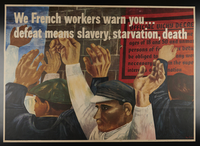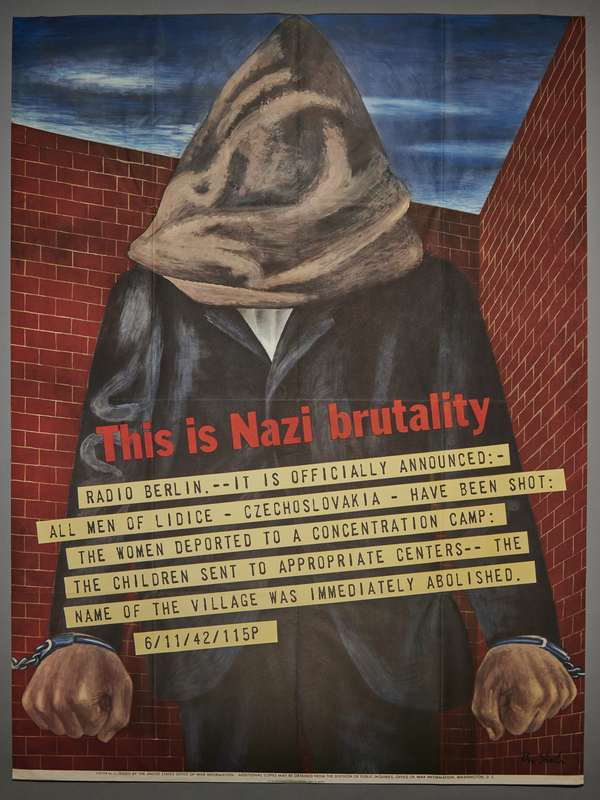Overview
- Brief Narrative
- Poster created by Ben Shahn for the US Office of War Information as a response to the Nazi-led annihilation and destruction of communities throughout the Czech Republic, including Lidice. It protests the retaliatory measures taken for the assassination by Czech resistance members of Reinhard Heydrich, a close associate of Himmler and Hitler and major implementor of the Final Solution for the Jewish problem. On May 1942, when Heydrich was acting Reich Protector in the former Czech provinces of Bohemia and Moravia, a hand grenade exploded under his car in Prague. Heydrich died on June 4 as a result of his injuries. Hitler personally ordered the destruction of Lidice, which occurred June 9, in retaliation for Heydrich's death.
- Artwork Title
- This is Nazi Brutality
- Series Title
- Office of War Information poster, no. 11
- Date
-
commemoration:
1942 June 11
creation: 1942
- Geography
-
manufacture:
United States
- Credit Line
- United States Holocaust Memorial Museum Collection, Gift of Yehuda Nir
- Markings
- front, across center of image : This is Nazi Brutality... / RADIO BERLIN.-- / IT IS OFFICIALLY ANNOUNCED:- / ALL MEN OF LIDICE - CZECHOSLOVAKIA - HAVE BEEN SHOT: / THE WOMEN DEPORTED TO A CONCENTRATION CAMP: / THE CHILDREN SENT TO APPROPRIATE CENTERS--/ THE NAME OF THE VILLAGE WAS IMMEDIATELY ABOLISHED. / 6/11/42115P.
- Contributor
-
Artist:
Ben Shahn
Producer: United States Office of War Information
Subject: Yehuda Nir
- Biography
-
Ben Shahn was born in Kovno,(Kaunus) Lithuania, on September 12, 1898. Shahn immigrated to Brooklyn, New York, in 1906. He first worked as a lithographer's apprentice until 1930 and was formally educated at NYU and the National Academy of Design in New York City. He was associated with the Social Realist movement and his work often joined striking visual images with compassionate and powerful political commentary. During World War II (1939-1945) he designed posters the Office of War Information. Shahn, age 71, died on March 14, 1969.
The United States Office of War Information (OWI) was created on June 13, 1942, to centralize and control the content and production of government information and propaganda about the war. It coordinated the release of war news for domestic use, and using posters along with radio broadcasts, worked to promote patriotism, warn about foreign spies, and recruit women into war work. The office also established an overseas branch, which launched a large-scale information and propaganda campaign abroad. The government appealed to the public through popular culture and more than a quarter of a billion dollars' worth of advertising was donated during the first three years of the National Defense Savings Program. Victory in Europe was declared on May 8, 1945, and in Japan on September 2, 1945. The OWI ceased operation in September.
Julius Gruenfeld (later Yehuda Nir) was born on March 31, 1930, in Lvov, Poland, to Samuel and Sidonia Grunfeld. Samuel was an affluent manufacturer of handwoven carpets. His sister Lala was born in 1924, After the start of World War II, the family fled to Romania, but after learning that Lvov fell under Soviet rather than German rule, they returned home. Under the Communist system, Samuel was classified a capitalist and the state confiscated his business and home. The family had to move into a smaller apartment in the same building. In June 1941, Germany attacked the Soviet Union and occupied Lvov. With German encouragement, angry Ukrainians turned on their former Jewish neighbors. In late July, Julius's father was arrested and murdered during the Petliura Days pogrom. Soon afterwards, a German officer moved into the Grunfeld's apartment and lived with them for the next six months. Though he stole their belongings at will, he also warned them of impending round-ups. A few months later, the Germans ordered all Jews to wear a white armband with a star. Ludwig Selig, an artistic Aryan-looking boyfriend of Lala, manufactured false papers for his family and friends. After a young of cousin of Julius's was murdered in Stanislawow (where he had been sent in the hope that it would be safer), the Grunfelds decided to plan an escape with Ludwig's help. Ludwig provided the family with both birth and baptismal certificates. Sidonia became Stanislawa Heybowicz, Julius assumed the identity of her son, Julian Heybowicz, and Lala became her niece, Halina Skrybaylo. To avoid detection by former Polish acquaintances, they decided to move to a different city. Lala traveled to Krakow with Ludwig while Sidonia and Julius hid separately. Julius went to the apartment of an aunt Sonia and uncle who were living on the Aryan side. The following morning four German policemen apprehended the aunt and uncle and took them to Janowska, a concentration camp outside of Lvov. They were released the following day since Sonia, who was the department head of the Polish Petroleum Agency, convinced the Germans that her work was essential to the war effort. However, after these events Julius left his aunt and uncle and hid instead with Sonia's Polish secretary until he could reunite with his mother and sister. Ten days later, Ludwig returned to Lvov to fetch Julius. He prepared new papers for Julius that identified him as a German Volksdeutsch. Riding in a railway car reserved for Germans, Ludwig talked openly with the German soldiers and explained to them that Julius was recovering from a serious bout with tuberculosis. After arriving in Krakow they first joined Lala and Julius' mother in a hotel and then rented a room in a small spa outside the city. Ludwig's mother and sister, Marysia, also moved there. Since the women looked Polish, they circulated freely in the town, but Julius, who looked Jewish, mostly stayed confined to the room. At the end of September 1942, the Gestapo captured and killed Ludwig. Afterwards, his mother and sister moved to a different town, since they decided it would be harder to link them to Ludwig in case the Gestapo learned that he had relatives. The following spring, the Grunfelds decided to move to a larger town where they would be less conspicuous. In March, Lala traveled to Krakow to meet with Ludwig's cousin and ended up witnessing the massive deportations from the Krakow ghetto. Shaken but still determined, they returned the following day with her mother only to be spotted by a Polish acquaintance from Lvov. The women took all their money and then informed on them to the Germans. The Germans arrested Sidonia and Lala but released them soon thereafter, after inspecting their papers. They also were convinced by Lala's flirtatious play-acting and protestations that the accusation was without basis. After the women returned to the spa, they felt increasingly threatened, especially after a trip by Julius to the barber shop sparked rumors in the town that they were really Jews. Sidonia and Julius returned to Krakow, while Lala went to Warsaw to find a new place for them to hide. After settling in Warsaw, Sidonia found a position as a housekeeper for Herr Rockshmidt, a wealthy German, and Lala was hired as a receptionist by his cousin, Dr. Adolf Schmoll, who was an SS dentist. Although Dr. Schmoll was an ardent Nazi and antisemite, unbeknownst to him two Jews in hiding in addition to Lala also worked in the office. After awhile, Lala found employment for Julius as well, as a messenger boy for another German dentist, Dr. Brabetz. The Grunfeld's situation greatly improved. Lala became Dr. Schmoll's chief assistant, and Julius learned new skills as a dental technician. Sidonia's employer admired her, provided for her wants, and allowed her the freedom to run the household. She even managed to host a sumptuous birthday party for Julius while her employer was out of town, and invited other Jewish friends who also were in hiding. Fearing the impending Soviet advance, the German civilian population began to leave Warsaw and return to Germany during the summer of 1944. Both Drs. Brabetz and Schmoll left, as did Herr Rockshmidt's family, though he first gave Sidonia the household belongings in appreciation of her devotion. On August 1, 1944, the Polish population of Warsaw began a popular uprising against the Germans. After a few weeks, Julius joined the resistance as a courier, despite the fact that he was only fourteen and barely eligible. On August 25, 1944, he officially became a member of the Armia Krajowa, the Polish Home Army, and became responsible for transferring ammunition from one locale to another. Lala also joined the resistance and worked as a medic. After the defeat of the Warsaw uprising in the beginning of October, the Grunfelds were sent with thousands of other Poles to Germany to work as forced laborers. They went by foot to Pruszkow, some 15 miles away, and there they boarded cattle cars that took them to Wilhelmshagen, a labor camp near Berlin. When they arrived at the camp, Sidonia asked a guard to contact her former employer, Herr Rockschmidt. The following day, he sent a car to pick them up and bring them to his estate. The family was granted privileged status and allowed to live in his mansion rather than outside with other workers. After being liberated by Soviet forces, they returned to Poland and contacted their family in Israel. They arrived in Haifa on November 13, 1946. Julius eventually graduated from medical school and became a child psychiatrist. He married and named his first son after Ludwig, the friend who provided the family with the false papers allowing them to survive. Yehuda, age 84, died in 2014 in New York City.
Physical Details
- Language
- English
- Classification
-
Posters
- Category
-
Anti-Nazi propaganda
- Object Type
-
Posters, American (lcsh)
- Physical Description
- Rectangular paper poster with an image of a man in a blue suit with a hood tied over his head. His clenched fists are chained to a red brick wall. Across his body is English text designed to look like the pasted strips from a telegram.
- Dimensions
- overall: Height: 37.750 inches (95.885 cm) | Width: 28.375 inches (72.073 cm)
- Materials
- overall : paper, ink
Rights & Restrictions
- Conditions on Access
- No restrictions on access
- Conditions on Use
- No restrictions on use
Keywords & Subjects
Administrative Notes
- Legal Status
- Permanent Collection
- Provenance
- The poster was donated to the United States Holocaust Memorial Museum in 2001 by Yehuda Nir.
- Record last modified:
- 2022-07-28 18:29:35
- This page:
- https://collections.ushmm.org/search/catalog/irn521356
Also in Yehuda Nir collection
The collection consists of artifacts: a badge, cigarette cards, leaflets, posters, and scrip and correspondence, documents, sheet music, and publications relating to the history of the Holocaust in Europe. Some of these materials may be combined into a single collection in the future.

Ben Shahn poster with an image of men with their arms raised in surrender
Object
Poster created by Ben Shahn for the US Office of War Information in 1942.
Yehuda Nir papers
Document
Collection consisting of magazines, newspapers, sheet music, documents, correspondence, scrip, booklets, pamphlets, books, playbills, political cartoons, leaflets, cigarette cards, and a patch (possibly fake).
Yehuda Nir papers
Document
The collection consists of World War II-era newspapers and magazines, American propaganda, scrip from Dora-Mittelbau, sheet music for Zionist songs, and other materials.




